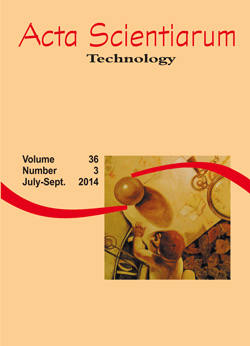<b>Extraction of total polyphenols from hibiscus (<i>Hibiscus sabdariffa</i> L.) and waxweed / `sete-sangrias´ (<i>Cuphea carthagenensis</i>) and evaluation of their antioxidant potential
DOI:
https://doi.org/10.4025/actascitechnol.v36i3.19093Keywords:
polyphenolic fraction, DPPH, natural extractsAbstract
Current research investigates the extraction process of total polyphenols from hibiscus (Hibiscus sabdariffa L.) and waxweed (Brazilian name: `sete-sangrias´) (Cuphea carthagenensis) and evaluates the antioxidant potential of their extracts. The extraction stage comprised investigation on the following parameters: i) solvents (acetone and ethanol) pure and fractioned with water; ii) variables (temperature, stirring, solvent ratio, time and pH). Total polyphenols were quantified by Folin-Ciocalteau reagent and antioxidant activity was determined by ABTS•+ (2,2′-Azino-bis(3-ethylbenzothiazoline-6-sulfonic acid) and DPPH (2,2-diphenyl-1-picrylhydrazyl) radical scavenging assay. Results showed that, depending on experimental conditions, total phenolic contents for hibiscus and waxweed ranged between 460.86 mg GAE 100 g-1 and 5012.54 mg GAE 100 g-1 and between 462.86 mg GAE 100 g-1 and 4215.99 mg GAE 100 g-1, respectively. Waxweed had a higher antioxidant activity when compared to that of hibiscus by both ABTS•+ and DPPH. Data showed that hibiscus and waxweed have a significant amount of polyphenols which may be extracted in mild processing conditions and then employed as natural antioxidant sources in industrial processes.
Downloads
Downloads
Published
How to Cite
Issue
Section
License
DECLARATION OF ORIGINALITY AND COPYRIGHTS
I Declare that current article is original and has not been submitted for publication, in part or in whole, to any other national or international journal.
The copyrights belong exclusively to the authors. Published content is licensed under Creative Commons Attribution 4.0 (CC BY 4.0) guidelines, which allows sharing (copy and distribution of the material in any medium or format) and adaptation (remix, transform, and build upon the material) for any purpose, even commercially, under the terms of attribution.
Read this link for further information on how to use CC BY 4.0 properly.



















8.png)




